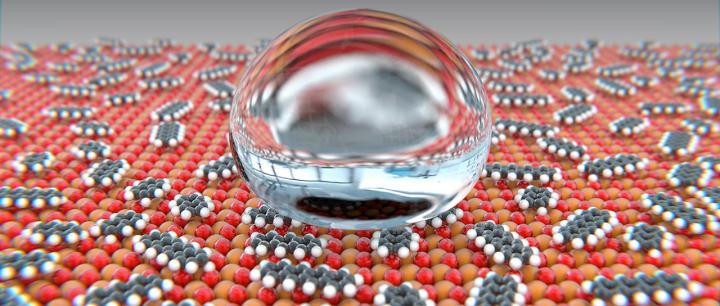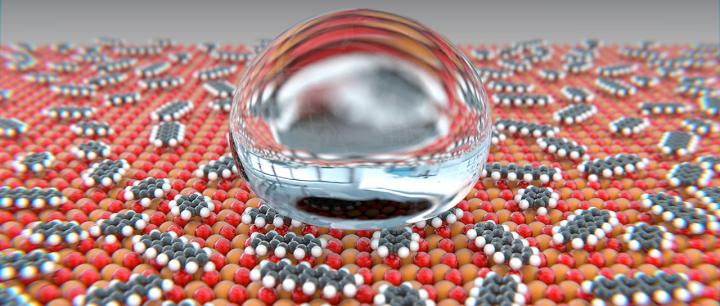
Credit: University of Basel, Department of Physics
Surfaces that have been coated with rare earth oxides develop water-repelling properties only after contact with air. Even at room temperature, chemical reactions begin with hydrocarbons in the air. In the journal Scientific Reports, researchers from the University of Basel, the Swiss Nanoscience Institute and the Paul Scherrer Institute report that it is these reactions that are responsible for the hydrophobic effect.
Rare earths are metals found in rare earth minerals. They are used today in, among other things, automotive catalytic converters and batteries, in the production of screens and lamps, and as a contrast agent in magnetic resonance imaging. Their broad range of applications means that there is a high demand for rare earths, and this demand is constantly increasing.
Additional uses for rare earths were opened up after American researchers reported in 2013 that surfaces that have been coated with rare earth oxides become water-repellent.
Scientists from the University of Basel, the Swiss Nanoscience Institute and the Paul Scherrer Institute have now worked with the company Glas Trösch to examine these hydrophobic properties more closely.
Water-repellency develops only after chemical reactions
The researchers coated glass pieces with rare earth oxides, nitrides and fluorides and analyzed how well they could be wetted with water.
They could not detect any hydrophobic properties when the coating was freshly deposited. It was only chemical reactions with gaseous hydrocarbons found in the ambient air that increased the surfaces' roughness and reduced wetting by water.
The gaseous organic compounds from the ambient air are first adsorbed by the surface and then react with the oxides to form carbonates and hydroxides until the surface is completely covered with these compounds. This process takes place even at room temperature.
"We were surprised that the hydrophobic effect was caused by the surface aging," says Professor Ernst Meyer, from the Department of Physics at the University of Basel, commenting on the results of the project supported by the Commission for Technology and Innovation (CTI). These conclusions are very revealing from a scientific point of view because catalytic processes also frequently take place at room temperature, which makes it important to understand the surface's physical properties.
The examined materials are, however, unsuitable for the industrial production of water-repellent glass surfaces, because the glass requires a sophisticated storage process before it shows the desired hydrophobic characteristics.
###
Media Contact
Ernst Meyer
[email protected]
41-612-073-724
@UniBasel_en
http://www.unibas.ch/
############
Story Source: Materials provided by Scienmag





